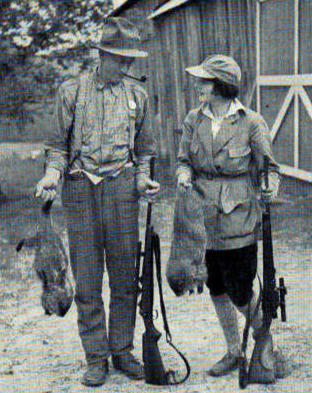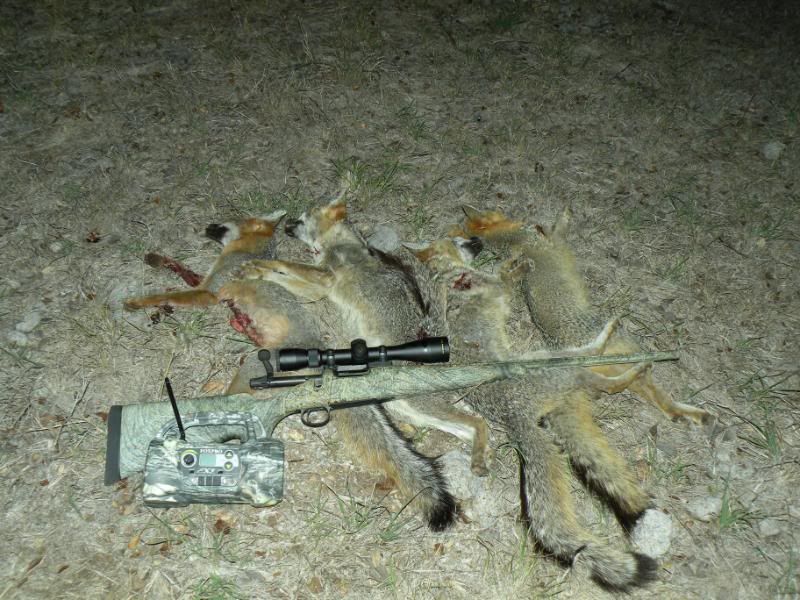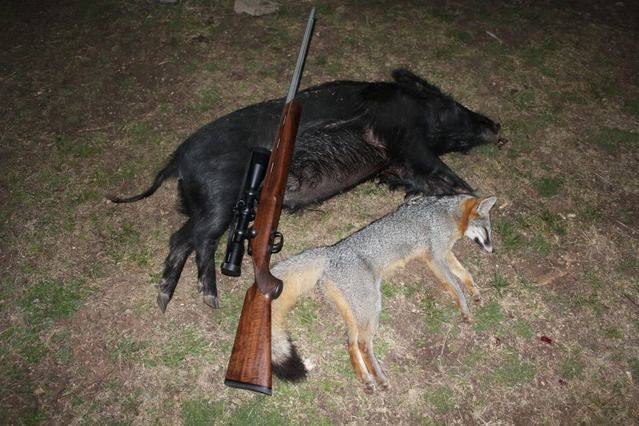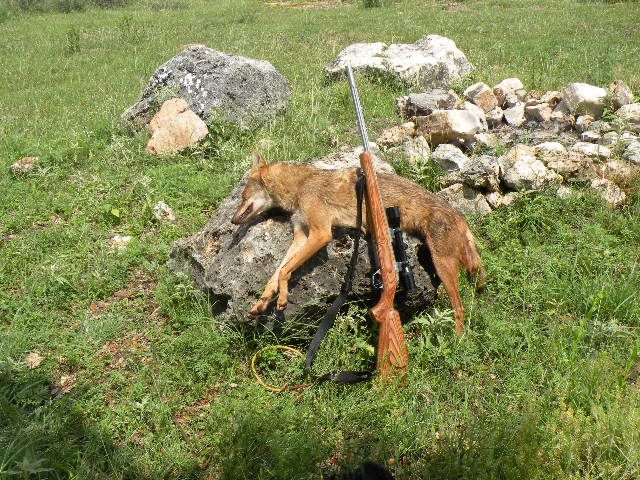

 The Accurate Reloading Forums
The Accurate Reloading Forums  THE ACCURATE RELOADING.COM FORUMS
THE ACCURATE RELOADING.COM FORUMS  Hunting
Hunting  Varmint Hunting
Varmint Hunting  Question fer all ya'll Pdog hunters?
Question fer all ya'll Pdog hunters?Go  | New  | Find  | Notify  | Tools  | Reply  |  |
| One of Us |
I've long been interested in the small calibers.......  However most of the varmints I shoot are called in to between 30 and 50 yards  Occasionally I"ll stretch out say 150......    to 250 yds+.....  Conseqently I typically zero rifles at either 100 or 200 yds and let fly. However, I've not been Pdogging where shots on small targets can be past 300 or so, but will probably do so next spring. So my question to all ya'll is what type of optics do you favor? Do you use mil-dot reticles, or do you zero and then dial up, or hold over? Thanx in advance, GWB | ||
|
| One of Us |
as you well know - i'm kind of a throwback, but i like the 6-24 scopes with a really fine crosshair or preferably a small dot. no mil dot or other clutter and i'll sight in for 300 and hold over/under from there | |||
|
| one of us |
+1 muck | |||
|
| one of us |
I really like the Leupold "ballistic reticles". They are very, very close to the designated yardages for most varminting calibers up to their maximum of 500 yards. The LR Duplex is available in the lower-priced lines and it works fine, but the aiming point dots are between .75 and one minute, so they can be a bit obscuring for PD's further than 300 yards. Regardless, I've used a 4-12X with LR Duplex very successfully up to 400 yards. The B&C reticle uses a finer line, has an intermediate 450 yard marker, and works well. But the Varmint Hunter reticle is probably the best of the lot for PD's, with its fine stadia lines combined with windage references. With any of these reticles, zero for 200 yards. Your elevation error from muzzle to 250 yards will be negligible. The intermediate stadia references are for 300, 400, (450), and 500 yards, respectively. It's easy to shade a bit high or low for targets at in-between ranges. I'm sure that there are other manufacturers which offer "ballistic reticles", and they may be just fine. I mention the Leupold models because those are the ones I'm familiar with and have found I can trust. I don't find the higher powers (over about 18X) to be particularly helpful. High power amplifies mirage distortion, but worse, the very narrow field of view makes acquiring your target more difficult, not to mention keeping your target in the FOV. You see, PD's have a tendency to scurry around every few seconds and may quickly run out of the FOV of a 24X scope, sometimes leaving you clueless as to their whereabouts. In my opinion (and experience), attempting to adjust your scope for elevation for every shot is not a winning proposition. In the first place, very few scopes will reliably move the identical amount each time they are adjusted. Secondly, moving your reticle several dozen times a day is bound to wear on the mechanism and lead to premature failure. And third, it is simply not practical since you may see shootable targets in the same sight picture that are a couple of hundred yards apart. Which one are you adjusted for? Can you remember. "Oh, wait, wait, let me come back down seven clicks -- oh no, that's for 300 yards and this one looks to be only 225, so I need to go -- how many clicks was that, now? There are those who will vehmently disagree with me I'm sure (mostly because they've spend megabucks for a customized reticle adjusting system and need to justify their decisions to do so.) But leaving your reticle in one place and selecting the stadia line which is closest to matching your target's distance is much faster and in my experience results in many more hits, in part because being faster you get off a lot more shots, which is the point, isn't it! Would you rather spend your time shooting at prairie dogs or constantly adjusting your scope? Besides, the greater aiming challenge when hunting prairie dogs is windage, not elevation. Bullet drop is always the same (at a given altitude and temperature), so it is relatively simple to compensate for. Windage is a bitch! The plains where you find the PD's is usually a rather windy place, with the wind being capricious and ever-changing. Even if the wind is blowing consistently from one direction, you'll be shooting in many different directions, so your hold-off is never quite the same. Look up the wind drift on the little .20 and .22 caliber bullets you'll be using and see just how much a 15mph Texas or Nebraska Panhandle wind can move them at 350 yards. All this is to say that no matter how sophisticated your elevation compensation, your windage (which no scope system can compensate for) is where the art of hitting PD's comes into play, and the only way to compensate for windage is to hold off for it and have a good spotter helping your call your shots as you walk them into your (ever moving) target. Calling the misses is the very most important factor in making the hits. By the way, having a rifle of low recoil and a scope sufficient FOV (low enough magnification) to see where your shots are hitting is a huge advantage in PD hunting. That's another reason that the extra high magnification scopes are less desirable since you can't see the bullet strikes. Half of the fun is seeing the PD go flying when you score, and you'll never see that with a .25-06 equipped with a 24X scope. Have fun, and be sure to report when you get back! | |||
|
| one of us |
GW: You didn't mention which specific caliber or calibers you might be using, but I know you like the "little guys". Me too. I've been up and down the scale, shooting rifles as large as .25-284 and as small as .22 LR. The larger 6mm's like .243 and .244 will make longer shots a little easier and do result in some spectacular "aerials" when you score. But they heat the barrel faster, are louder and more disturbing, and even though most people think of the recoil from these rounds as quite mild, you'd be surprised at how fatiguing shooting one of them dozens of times in a day can be. Our group of hunters has found that the modest size .22's (.222/.223), in the hands of an experienced shooter who can dope the wind, are capable of making hits about as far away as any caliber. All of us own .22-250's and even a couple of .220 Swifts, but we haven't really found any advantage to the larger .22's, so they stay at home now. Besides, they just heat the barrel faster and empty the powder measure quicker. But if small is better, smaller is even better. The .221 Fireball is now everyone's favorite using a 40 grain tipped bullet at about 3400 fps. On my last trip I took a new-to-me .20 Vartarg and lit 'em up at distances as long as 400 yards. As you know, these "little guys" are quieter, have no appreciable recoil, are slow to heat the barrel in long shooting strings, and you can always see your own hits and misses -- which is more than half of the fun. I always take at least one of my Hornets along. As long as the target is inside of 200-225 yards, a sharp-nosed bullet in an accurate Hornet can be deadly. Now, I haven't thrown away my .244 HB with the 6.5-20 scope; and I'll admit that clobbering a PD at 550 or 600 yards with a "big gun" is an accomplishment and fun to try. But the meat-and-potatos of PD hunting comes between 200 and 350 yards or so. In this range the "little guys" have all the fun. | |||
|
| one of us |
I shoot everything from 22lr to 300 win mag. with the bulk of shooting with the 22ppc, 223,6mmbr, &25BR. Less powder and barrels last longer. We shoot at anything from the muzzle to infinity, with most in the 200-400 yard range. I have a variety of scopes, I prefer fine cross hair or a 1/8th minute dot. I have a couple of mil dot or multiple dot, hash mark for windage etc. but prefer to dial the scope for elevation. I have always used the 1 dog wind, 2 dog etc. method for windage- it is fast and works for me. I shoot the bulk of the time on about 12x, it gives a decent field of view to watch the hits and a little less eye strain when shooting all day long. | |||
|
| One of Us |
SC, I figure on a 17 ackley hornet 20 Vartarg 20 Tactical (20-223) 221 fireball 222 Rem. 223 Rem. 223 AI (8 twist) 6BR 6-284 maybe Thanks for all the input guys. It sure gives me a bunch of things to ruminate on. I'll probably zero different rifles at 100, 200 and 250 yds. I've got a couple of the Leupold CDS scopes and one scope with B&C reticule. Will probably churn a couple rifles and add a couple mil-dots between now and April. I'm a member of a range that is 10 minutes away from my house that I can shoot to 300 yds. Should be good to go by April. Best, GWB | |||
|
| one of us |
Stone, I think I've finally figured out the "elevation" thing BTW....I set the zero of my PD scopes for maximum point-blank range. My VHR's are still a work-in-progress. Kevin  | |||
|
| one of us |
Looks like you have a stable full of rifles that will fill the needs. I would bring the 6/284 for some fun at some really long shots. I always bring a 22/243 to send some 75gr Amax way out there, along with a couple of 257DGR to shoot some with 115 Berger's and it is really fun to shred a few with 75gr Vmax. My son really enjoys the 300 Win Mag with 150 gr SST on some 500-600 yard stuff- says it is good practice for big game. | |||
|
| One of Us |
My primary PD rifles are a Remington M-700VS in 223 and a Savage M-12LRPV in 204. Both wear a Leupold VX-III 6.5-20 with their Varmint Hunter reticle. I have found that reticle to be very useful at all ranges and especially nice when the wind blows. Most of the time the scope is set about 12X to 16X but about 10% to 20% of the time I can use the full 20X magnification | |||
|
| one of us |
| |||
|
| One of Us |
No problem Ray 17 ackley hornet 17 hebee 17 Mach IV 17 Fireball 17 Remington 20 Vartarg(20-221 Fireball) tactical 20 22 hornet 218 Bee 221 Fireball 222 Remington 223 Remington 223 Remington Ackley Improved 22-250 Rem. 220 Swift IIRC Best, GWB | |||
|
| One of Us |
I can't add much to what Stonecreek said . My pdog rifle ugly Savage .223 even uglier Choate stock..Leupold 6 X 20 varmint reticle. I'm toying w/ idea of a 6 br build , any comments on 6 br for pdogs ?? | |||
|
| one of us |
The 6 br is an excellent PD cartridge, mine is a 14 twist so I can't shoot the big stuff, but then there is no recoil with the 55-70 gr stuff. | |||
|
| One of Us |
My F/TR 223 is the most fun prairie dog gun for me. Not the best ballistically but so little recoil I can watch the bullet fly downrange. After 400 or so yards it's way easier to hit them with a more aerodynamic bullet going faster. Love shooting precision and long range. Big bores too! Recent college grad, started a company called MK Machining where I'm developing a bullpup rifle chassis system.  | |||
|
| One of Us |
We shoot near the badlands in SoDak and most days after may it gets pretty hard to use more than 10 or 12X after 10am due to heat and mirage. I do like the Leupold Varmint reticle. It gives multiple reference points to adjust fire from and usually by the first time we move up on a town I can have things pretty well figured out (holds for wind). It has improved my consistency greatly past 300. You are in for a great time! I may be a bit sadistic, but it is hard to beat the combination of marksmanship challenge and endless live targets that fly, chunk, pop, and mist! Also if you sneak back in in the evening and cover up you have a great chance at scavengers. You will have a great time. | |||
|
| Powered by Social Strata |
| Please Wait. Your request is being processed... |
|
 The Accurate Reloading Forums
The Accurate Reloading Forums  THE ACCURATE RELOADING.COM FORUMS
THE ACCURATE RELOADING.COM FORUMS  Hunting
Hunting  Varmint Hunting
Varmint Hunting  Question fer all ya'll Pdog hunters?
Question fer all ya'll Pdog hunters?

Visit our on-line store for AR Memorabilia

